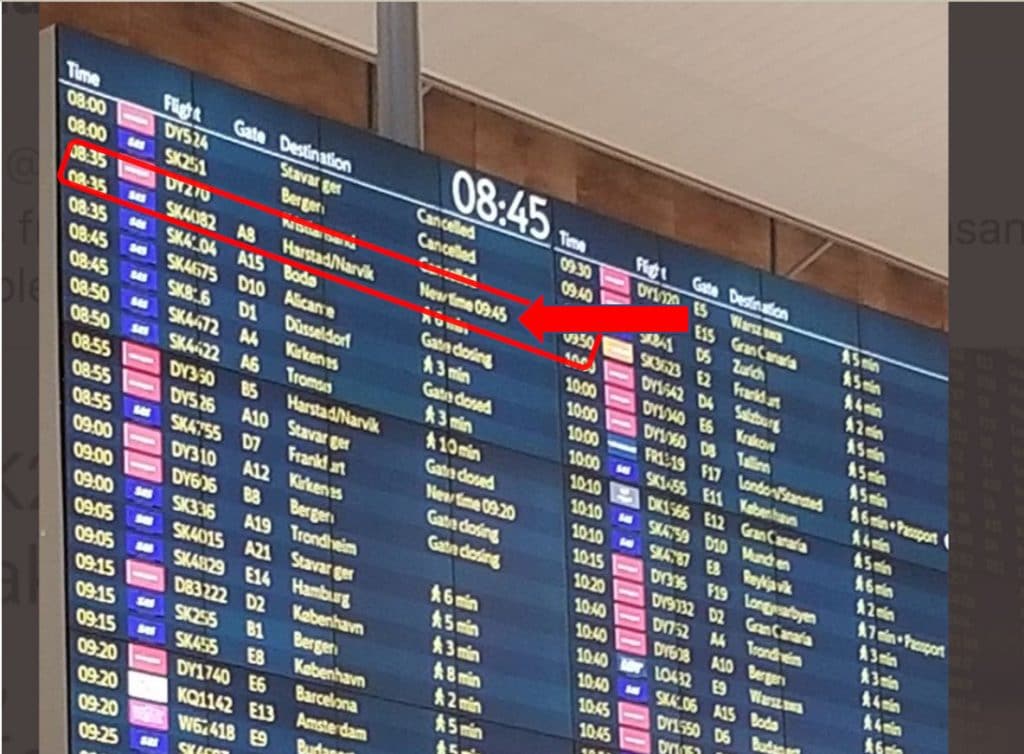Recently I had the displeasure of being mishandled by TripIt, after their paid Pro app put me (and some cherished travel mates) at risk, prompting a frustrated tweet from me about the negative experience. As a million+ mile traveler, I was excited to test the power of TripIt Pro – yet not aware how TripIt Pro data can be wrong, making the service potentially unreliable for crucial, in-the-field travel decisions. More important than our experience with TripIt Pro are the lessons professional reputation managers can learn from TripIt’s subsequent attempt to deescalate the situation.
Whilst traveling in Norway, TripIt Pro alerted me we had missed our Oslo connection to Harstad/Narvik (EVE) and provided a link to pursue alternate flights. I reflexively clicked on the link to start the process of rebooking.
Had we followed TripIt’s alert, we would have rebooked our flight for no reason, potentially wasting a lot of time and energy – not to mention the potential financial implications of rebooking without cause. Here’s what went wrong:
- The first leg of our trip, Bergen to Oslo was late, thus the supposed missed connection.
- TripIt Pro failed to track that the second leg, Oslo to EVE, was also nearly an hour late.
- As such, we easily made the EVE flight after almost an hour layover in Oslo.
Fortunately, my travel mate’s Google Trips alert flagged both flights as late almost three hours before the FIRST leg, and about six hours before the second.
This picture of the flight board in Oslo, about 10 minutes after we landed from Bergen, shows we had the full hour to make the EVE flight, far from needing to rebook.
After the stress of receiving a faulty alert to rebook, I tweeted my concerns:
A TripIt reputation manger first responded on Twitter for me to check my email.
“Feedback” was a curious word. “Support?” I wondered if TripIt was going to scold me or provide input as a basis for my improvement.
TripIt’s email response, while seemingly innocuous, was poorly executed from the professional reputation manager’s point of view. Their approach made classic reputation management errors, missing opportunities to lower the temperature, help this TripIt paying customer feel better about the app, put TripIt usage in better perspective, and retain a paying customer. Here’s their email, followed by lessons to learn for reputation managers.

- TripIt declined to take true responsibility for faulty data, instead blaming its vendors. Blaming others does not mitigate my expectation that the TripIt Pro application using vendor data works properly. A vendor’s bad data is TripIt’s bad data. Blaming others makes a company look small. If you must blame, cite more specific steps you are going to take with the faulty vendor, not just that you’ll report the bad data.
- The email was classic CYA, all about TripIt, and little about the user’s experience. TripIt had almost no empathy for what the error may have meant to me personally in this case. “Our apologies for any inconvenience,” is too impersonal, a boilerplate response when tendered on its own. TripIt needed to add a level of customization to acknowledge why this may have been particularly frustrating to me. How about “We understand this is your first use of TripIt, since going Pro, and we are sorry to disappoint you” or “When traveling abroad, we know it’s especially important that flight data be up to date.”
- TripIt provided financial compensation (I did not ask for) in an insultingly small amount, $4.08 to be exact, just days after I spent $49.99 for a service that failed me on the first outing. Reputation managers, if you decide to compensate a user when they did not ask, make it valuable. It would have still been a small token to credit me for the entire second year, thus also making a statement that TripIt hoped to retain me as a customer. $4.08, seriously? Why come off as massively cheap when I did not request a refund in the first place?
- Say the customer will be part of a greater solution. Try, “In the future we’ll be more forthcoming on the surface about the data behind of flight alerts in TripIt Pro. They could have said, “At current we tell customers that there is a slight chance the data will be updated late, in our terms of services” (which also defends legally). “As a result of situations like yours, we will consider placing disclosures closer to the surface of TripIt Pro’s UI for the rare chance our data updates slower than we would like” (which also says such problems are rare and commits to nothing other than consideration).
- No service is perfect, which is reasonable. A company like TripIt can get out ahead of complaints by marketing the percentage of reliability up front, i.e. 98.7 percent accuracy. Then they would have had that quality of service promise ready at their fingertips for situations like this. Providing no QOS promise means users will expect 100% quality of services. One of the reputation manager’s best friends is smart front-end marketing.
- Invite the complainant to speak with someone at the company, if they so desire. Little is as powerful for diffusing an upset customer.
- The generic, “Please keep us posted about any alerts anomalies in the future” asks me (the customer) to engage proactively to solve TripIt’s problem. Next time, tell the customer, “With your permission, I’ll reach out next week to see how the rest of your trip went with Pro.”
TripIt seems to have good reasons to be magnanimous with customers expressing concern. The service is not foolproof and dependent on third party data, potentially putting travelers’ dependence on TripIt at risk.
This flier claimed TripIt cost her $1,200, stating, “This is another case of a company making claims they can’t live up to and then falling back on their user agreement as a way of not accepting any responsibility when their technology fails.” Read that blog post for other cringe-inducing reputation practices in the exchanges with that unhappy traveler. Others have had sketchy experiences with TripIt. TripIt, the brand, is vulnerable. Search interest in TripIt has been declining for years and Google seems poised to eat TripIt’s lunch.
Compare TripIt’s search interest decline against Google Flights, a free service that also tracks itineraries mined from a user’s gmail inbox.
More importantly, TripIt seems to be in the business of subtly disrespecting customers by lack of empathy and customer service savvy. TripIt’s email response, while superficially harmless, was feebly effective from the professional reputation manager’s perspective. Their attitude made archetypal reputation management mistakes, missing a chance to please and retain a paying customer. TripIt’s folly offers good PR perspective for reputation managers.



















